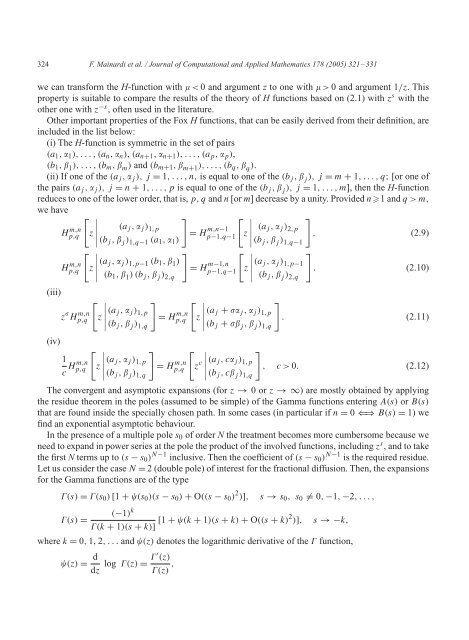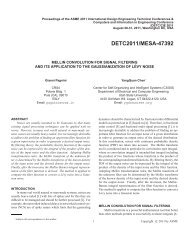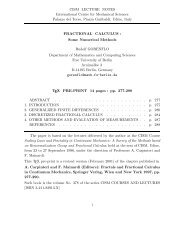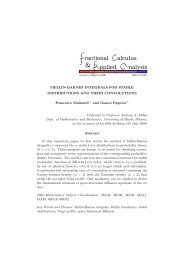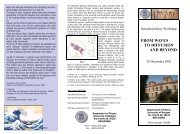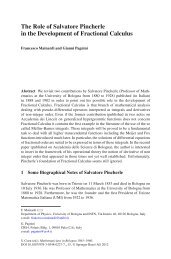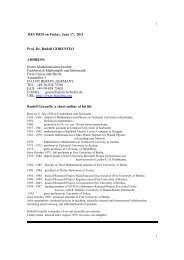Fox H functions in fractional diffusion - FRActional CALculus ...
Fox H functions in fractional diffusion - FRActional CALculus ...
Fox H functions in fractional diffusion - FRActional CALculus ...
Create successful ePaper yourself
Turn your PDF publications into a flip-book with our unique Google optimized e-Paper software.
324 F. Ma<strong>in</strong>ardi et al. / Journal of Computational and Applied Mathematics 178 (2005) 321–331<br />
we can transform the H-function with < 0 and argument z to one with > 0 and argument 1/z.This<br />
property is suitable to compare the results of the theory of H <strong>functions</strong> based on (2.1) with zs with the<br />
other one with z−s , often used <strong>in</strong> the literature.<br />
Other important properties of the <strong>Fox</strong> H <strong>functions</strong>, that can be easily derived from their def<strong>in</strong>ition, are<br />
<strong>in</strong>cluded <strong>in</strong> the list below:<br />
(i) The H-function is symmetric <strong>in</strong> the set of pairs<br />
(a1, 1),...,(an, n), (an+1, n+1),...,(ap, p),<br />
(b1, 1),...,(bm, m) and (bm+1, m+1),...,(bq, q). (ii) If one of the (aj , j ), j = 1,...,n,is equal to one of the (bj , j ), j = m + 1,...,q; [or one of<br />
the pairs (aj , j ), j = n + 1,...,p is equal to one of the (bj , j ), j = 1,...,m], then the H-function<br />
reduces to one of the lower order, that is, p, q and n [or m] decrease by a unity.Provided n1 and q>m,<br />
we have<br />
H m,n<br />
<br />
<br />
<br />
(aj , j ) 1,p<br />
p,q z <br />
= H<br />
(bj<br />
, j ) 1,q−1 (a1, 1)<br />
m,n−1<br />
<br />
<br />
<br />
(aj , j ) 2,p<br />
p−1,q−1 z <br />
, (2.9)<br />
(bj<br />
, j ) 1,q−1<br />
H m,n<br />
<br />
<br />
<br />
(aj<br />
, j ) 1,p−1 (b1, <br />
p,q z<br />
1)<br />
<br />
= H<br />
(b1, 1)(bj , j ) 2,q<br />
m−1,n<br />
<br />
<br />
<br />
(aj<br />
, j ) 1,p−1<br />
p−1,q−1 z <br />
. (2.10)<br />
(bj , j ) 2,q<br />
(iii)<br />
z H m,n<br />
<br />
<br />
(aj<br />
, j ) 1,p<br />
p,q z <br />
= H<br />
(bj<br />
, j ) 1,q<br />
m,n<br />
<br />
<br />
<br />
(aj + j , j ) 1,p<br />
p,q z <br />
. (2.11)<br />
(bj<br />
+ j , j ) 1,q<br />
(iv)<br />
<br />
1<br />
<br />
m,n (aj<br />
, j ) 1,p<br />
Hp,q z <br />
= H<br />
c (bj<br />
, j ) 1,q<br />
m,n<br />
<br />
p,q z c<br />
<br />
<br />
<br />
(aj<br />
,cj ) 1,p<br />
<br />
, c>0. (2.12)<br />
(bj<br />
,cj ) 1,q<br />
The convergent and asymptotic expansions (for z → 0orz →∞) are mostly obta<strong>in</strong>ed by apply<strong>in</strong>g<br />
the residue theorem <strong>in</strong> the poles (assumed to be simple) of the Gamma <strong>functions</strong> enter<strong>in</strong>g A(s) or B(s)<br />
that are found <strong>in</strong>side the specially chosen path.In some cases (<strong>in</strong> particular if n = 0 ⇐⇒ B(s) = 1) we<br />
f<strong>in</strong>d an exponential asymptotic behaviour.<br />
In the presence of a multiple pole s0 of order N the treatment becomes more cumbersome because we<br />
need to expand <strong>in</strong> power series at the pole the product of the <strong>in</strong>volved <strong>functions</strong>, <strong>in</strong>clud<strong>in</strong>g zs , and to take<br />
the first N terms up to (s − s0) N−1 <strong>in</strong>clusive.Then the coefficient of (s − s0) N−1 is the required residue.<br />
Let us consider the case N = 2 (double pole) of <strong>in</strong>terest for the <strong>fractional</strong> <strong>diffusion</strong>.Then, the expansions<br />
for the Gamma <strong>functions</strong> are of the type<br />
(s) = (s0) [1 + (s0)(s − s0) + O((s − s0) 2 )], s → s0, s0 = 0, −1, −2,...,<br />
(−1)<br />
(s) =<br />
k<br />
(k + 1)(s + k)] [1 + (k + 1)(s + k) + O((s + k)2 )], s →−k,<br />
where k = 0, 1, 2,...and (z) denotes the logarithmic derivative of the function,<br />
(z) = d<br />
dz log (z) = ′ (z)<br />
(z) ,


